Derek the Hybrid Detective
Click browser's "Back" button to return.
DD1206b Neoregelia Red Waif/Cayenne
Revisited, 12/2006, by Derek Butcher.
In July 1984 Brian Smith in his Manuscript of Bromeliad Hybrids and Cultivars reported Neoregelia ampullacea Zebrina x Fireball (DeLeon) and also Neoregelia Fireball x ampullacea Zebrina (DeLeon).
In the Preliminary Listing by Don Beadle in 1991 only Neoregelia ampullacea Zebrina x Fireball is listed under DeLeon List #3.
In the BSI Journal Jan/Feb 1994 Neoregelia Red Waif is listed as Zebrina x Fireball. This is a Hendrix hybrid grex #7902 but named by Carol Johnson of Pineapple Place. Only one plant was selected from the grex!
Ever since the Bromeliad Cultivar Registry 1998 was issued I have been aware that plants with parental formula only will be lost to the “official” Bromeliad World and all worthwhile cultivars needed names so that they could be catalogued.
In 1999 my wife and I pondered over our Neoregelia Fireball x ampullacea which we had obtained from Margaret Paterson of Gympie in Queensland in 1996 which seemed to be identical to one with the same name from Olive Trevor of Brisbane in 1993. It was clearly being grown widely in Australia so we decided to call it Cayenne and announced this fact in a printed update on Australian Cultivars at the Cairns Conference in 1999. A photograph of this plant is shown on http://fcbs.org
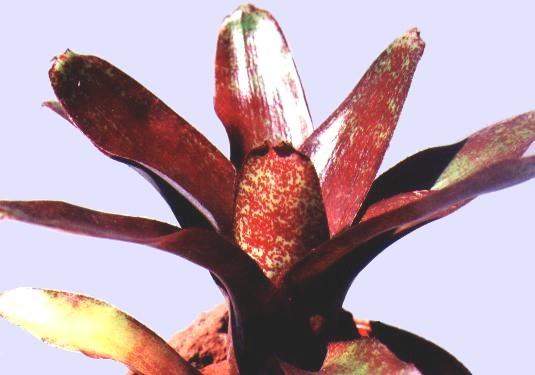
Neoregelia Fireball x ampullacea = Cayenne.
From Margaret Paterson(1996) & Olive Trevor(1993). |
In April 2000 Geoff Lawn of Perth sent me photographs of Neoregelia ampullacea x Fireball (note the reversal of parentage) that he had received from Olive Trevor in 1997 and an identical looking plant with the same parentage from Grace Goode from the Sunshine Coast in Queensland.
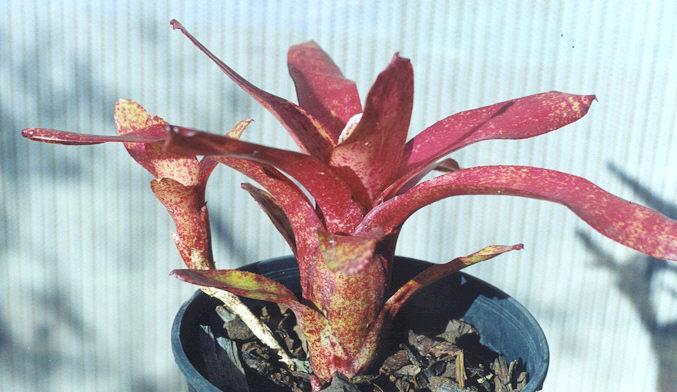
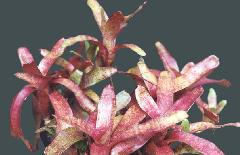
| Neoregelia ampullacea x Fireball. Photo Geoff Lawn. |
| From Olive Trevor, 1997. |
From Grace Goode. |
Geoff had linked them to our Cayenne and he could well be correct. Also growing in Perth is a plant called Neoregelia ampullacea ‘Red Form’ that they inherited from the Cairns Bromeliad Study Group that had brought plants to Perth for their Bromeliad Conference in September 1997. This also seems identical and the Cairns Bromeliad Study Group after ‘studying’ the problem have the same thoughts! They also advise me that you can also get this plant in Brisbane under the name ‘Red Wave’ (sic) which may confuse even more especially where there is already a ‘Red Wave’ and a ‘Red Waves’ in the Register which have no link whatsoever!
AND THAT’S NOT ALL. Don and Alice Woods, also of Perth, had imported a Neoregelia ‘Red Waif’ from Pineapple Place Nursery and this seems identical to all plants mentioned so far!
1. We know that a true species crossed with another true species will produce like progeny at this F1 level.
2. We know that the ICNCP rules (Rule2.15) allow for a cultivar name to be given to all these like plants.
3. I have kept a close watch on Australian hybridising since before 1982 and no similar combination has been tried in Australia.
4. Also in the 1991 Preliminary Listing is a Neoregelia ampullacea (without the Zebrina) x Fireball in Tropiflora catalogue in 1986 but Dennis Cathcart has always been a “middleman” so while this has been considered it is treated here as a red herring!
5. We know that DeLeon preferred formulae to Cultivar names and that some of the hybrids he offered had in fact been done by Hendrix although not stated as such. Therefore we can be fairly sure that the formula plants came from DeLeon..
6. Hendrix could easily have used the same parental clones to produce Neoregelia ampullacea Zebrina x Fireball (Even at the same time in the same flower head). Each seed berry could produce similar progeny so the significance of Grex #7902 seems less important in this situation.
7. While I have strong feelings that Red Waif and Cayenne could share the same name I intend to show both in the Bromeliad Cultivar Registry and link them as being probably identical.
8. Comparison of photographs of all participants can be made on http://fcbs.org
9. This situation proves, at least to me, that formulae are essential to the hybridist for the correct interpretation of results but if a plant is then worthy of growing and/or selling it is worthy of a name in its own right.
If you have any other evidence in this saga please advise.
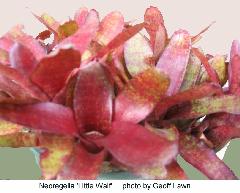
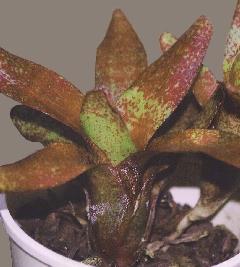
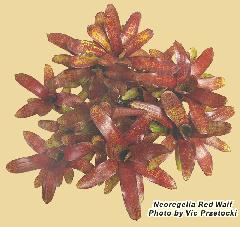
| Red Waif, as Little Waif. Photo Geoff Lawn. |
Red Waif. Photo Upton. |
Red Waif. Photo Vic Przetocki. |
December 2006
Let us now look at further developments. In 2006 we heard that Don and Alice Woods had imported a ‘Little Waif’ at the same time as Red Waif. It was called that because it was smaller but nobody knows how big Red Waif should be! The name ‘Little Waif’ is also in use in Florida. Investigation with the hybridist came to a dead end because naming had been done by Carol Johnson of Pineapple Place. ‘Little Waif’ is now in the Cultivar Register, mainly as a reference. From the above, we know that grex #7902 got to Australia under formula to become ‘Cayenne’. There is now more intrigue because we have been growing a Neoregelia ampullacea Zebrina in Australia for many years which does not look like a cultivar of N. ampullacea. Does it link with N. ampullacea ‘Red Form’ or ‘Red Waves’ as mentioned above? Another contact with Gary Hendrix reveals that he got his Neoregelia ampullacea Zebrina. from David Barry's Jungle Gardens in California labeled Neo. zebrina! This plant is not the same as the Aussie Zebrina which suggests to me that it is another one from grex #7902 but the pollen parent got lost on the label! It seems safer to call this clone Zebrina Waif.
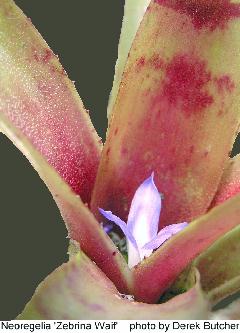
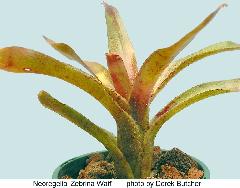
| Neoregelia Zebrina Waif. Photo Derek Butcher. |
It is ironical that a waif is an unwanted animal or person but this seems to be cropping up everywhere. Are there any more waifs for me to fall over?
Updated 28/12/06








